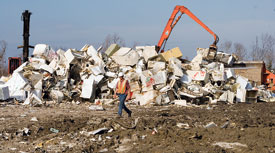 |
 |
| (Photos by Michael Goodman for ENR) |
Nestled in the valley of Mount Katrina, roughly 20 mucky acres on the eastern end of the recently reopened, massive Old Gentilly Landfill in eastern New Orleans, lies the white goods processing and staging area.
The white goods waste stream is comprised of stoves, washers, dryers, household appliances, air conditioners, water heaters and big, smelly refrigerators. When a half million New Orleanians evacuated, they left behind refrigerators and freezers full of what people love to eatpots of red beans and rice with sausage, gumbo, shrimp, fish, venison, alligator sausage and andouille. Mix it together, seal in an airtight container, turn off the power, add heat, let it fester and ferment for two months, or six, and you have an odorous problem.
Smell may not be easily conveyed in print, but the abundance of maggots, brown goo and respirators [worn by workers] offers a hint of the pungent aroma that has wafted through virtually every neighborhood in the city for the past few months as residents placed their fridges curbside. At Mount Katrina it all comes together in an odoriferous concentration. Here the appliances enjoy a brief interlude on their journey from loving homes to Southern Scrap, a local recycler. This is where the environmental response team, a joint venture of the U.S. Environmental Protection Agency, U.S. Coast Guard and Louisiana Dept. of Environmental Quality, extracts and recovers freon from units before they are crushed and sent to the recycler. We have collected a total of 301,776 units says Cindy Fanning, information officer for the response team. From that, 268,802 units have had freon extracted.
|
Al Probyn is site supervisor for the Corps. For a guy like me, this is like heaven, says Probyn, who grew up on a farm in Glassford, Ill., and served a stint in a meat-packing plant in Colorado. Probyn says the white goods detail offers a stimulating social viewpoint of the human condition. In addition to storing food, refrigerators serve as glaring billboards and panoramas of peoples lives. Many sport angry post-Katrina messages spray painted in vivid colors, as well as the usual photos and magnets and phone numbers. He says the most surprising is the amount of pornography thats turned up stored in freezers.
You can tell a lot about people by what they eat, says Probyn as a crew in hazmat suits approaches a line of refrigerators, spreads a huge sheet of plastic and opens the doors to dump the contents for wrapping and burial. They call it refrigerator gutting.

Post a comment to this article
Report Abusive Comment